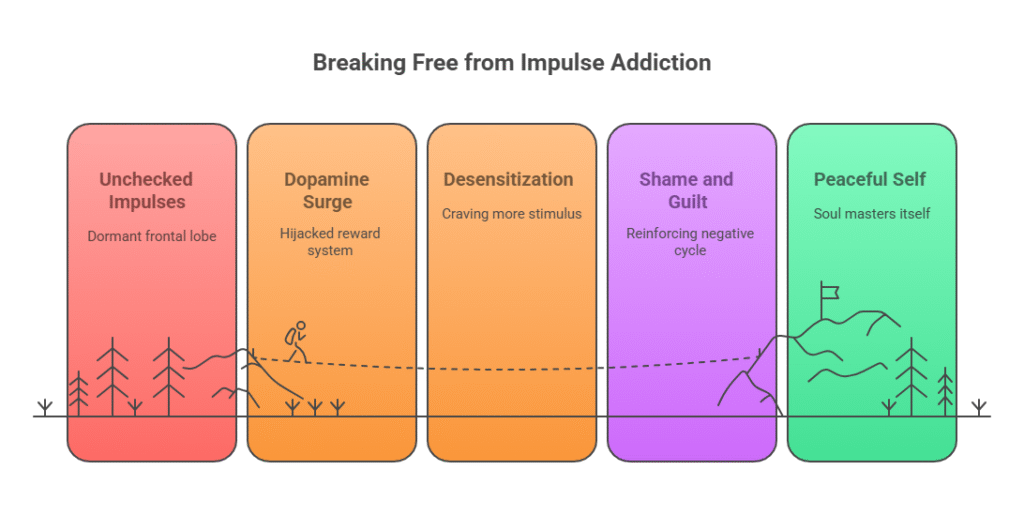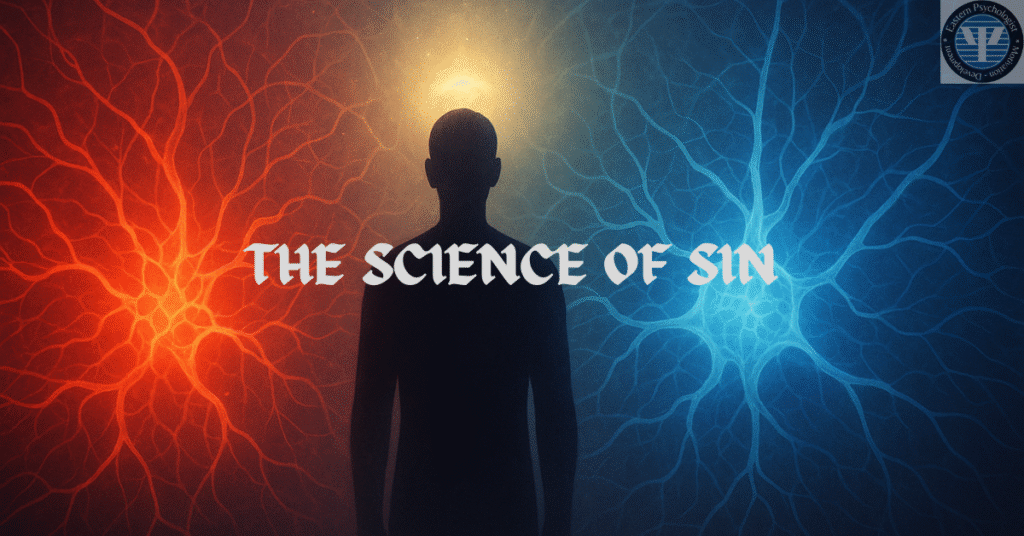8 min read time
Update on October, 7, 2025
Table of Contents
Author’s Note: This is a mixed formal case study based on typical situations seen in clinical settings. All the personal details have been altered to maintain personal confidentiality.
It was just a matter of a single click. Adil is in his dorm room and has some undefined emotions, stress, loneliness, or boredom. He chooses to click on a link despite his hesitation, and this brings him into the trap of want and impulsive action. His case is an illustration of a widespread trend in the contemporary world where a number of compulsive addictions appear, such as scrolling the doom feed, addictive gaming, and overeating, which are defining the modern psychology and tend to overwhelm the will. Then it is hard to crawl out of, thus, to understand this addiction, we must look inside the brain, the brain control center, where temptation and choice collide.
At the same time, this brain center does decent functioning. This is due to its decision-making and moral restraints. Yes, I am talking about the Frontal lobe.
The Frontal Lobe: The Brain’s Inner Executive
The prefrontal cortex is located in the frontal lobe. It functions as the executive control center of the brain. It is capable of decision making, planning, emotional regulation, and anticipation. This region is located just behind your forehead. (Miller & Cohen, 2001). Neurologically speaking, the frontal lobe acts like the brakes on a speeding car. It is what convinces you not to send an angry message in a heated conversation.
However, the prefrontal cortex does not mature till the mid-20s. Maybe later in males(Arain et al., 2013). This factor explains why adolescents are impulsive in their behavior.
Impulse addiction, then, can be perceived as the battle between an overstimulated limbic system (happy brain) and a fatigued or even immature prefrontal cortex. The limbic system is pleasure-seeking, and the frontal lobe is a promoter of patience, creating conflict in which the logic fails to resist instant gratification.
But what happens when the whisper isn’t loud enough?
This inner conflict may result in addiction to impulses and affect self-manipulation or manipulation of others with the purpose of getting some personal benefits and easy pleasures (Lobbestael et al., 2024). The obsession with social validation via social media, where individuals present the picture of perfection when they are not feeling good internally, is one of them. This normalization of behaviors poses very dangerous stereotypes in our cyber worlds..

Dopamine: Reward system
Dopamine, one of the most important neurotransmitters, is activated in pleasurable activities supporting the survival behaviors (Schultz, 2015). Although normal amounts of dopamine are normal, it has been found out that new technologies tend to exploit dopaminergic (volkow et al., 2017).
Such technologies as social media apps are meant to stimulate the dopamine-rewarding system. As we scroll or swipe, it gives an exciting signal to dopamine release. Similarly, pornography, binge-watching, and online shopping supply dopamine hits quickly and easily with little or no effort (Volkow et al., 2017). These are all micro-pleasures that leave our brain restless, seeking satisfaction but never satisfied.
Prolonged exposure leads to neuroadaptation. The brain requires progressively larger stimuli to achieve the same pleasure response. This phenomenon leads to desensitization (Koob & Volkow, 2016). The prefrontal cortex’s inhibitory control weakens. Because individuals engaging in compulsive impulsive behavior feel minimal pleasure, yet feel unsatisfied
The use of this dopamine behaviour is typical in dark psychology. For example, one can take the emotional manipulation tactic, guilt, or flatter to get the intended reaction. At the same time, knowing very well how to activate the reward circuits in the brains of others. We can become the victims of such influences due to the weaknesses of our psychological composition. But don’t worry, you can reclaim your control over this manipulation. Let’s talk about the spiritual point of view and the frontal lobe.
A Deeper Battle: The Nafs and the Frontal Lobe
Islam has a term, Nafs, which refers to the lower self or ego as a force that influences us into the base desires (Rothman et al., 2018). The Qur’an describes the three stages of Nafs as commanding (Nafs al-ammarah), blaming (Nafs al-lawwamah), and peaceful (Nafs al-mutma-innah).
From a neuropsychological perspective, these stages mirror levels of self-regulation (Rothman et a2018). The (Nafs al-ammarah)parallels unchecked impulses and a dormant frontal lobe. The conscience initiated is called (Nafs al-lawwamah). Follower of pleasure is the guilt, which is an indication that the prefrontal cortex is attempting to take over. The (Nafs al-Mutmainnah) is a harmony of the soul when the soul has acquired control over itself and dopamine ceases to be the master.
Faith and neuroscience meet in an attractive harmony. Both describe the same inner war using different languages.
This interplay between neuroscience and spirituality is not coincidental. In fact, the struggle between the nafs and the aql (intellect) is mirrored by the neural tug-of-war between the limbic system and the prefrontal cortex.
The Internal War: Shame, Guilt, and the Psychology of Relapse
The shame frequently accompanies addiction to the impulse that something is wrong with me. But psychology makes a distinction between guilt, which can be used as a drive toward positive change, and shame. Which is the cause of self-hate and subsequent indulgence (Derakhshandeh et al., 2023).
This distinction is essential. Because the wrong kind of guilt can chain you deeper into the cycle you’re trying to escape.
Imagine this cycle:
- Trigger (stress, boredom, sadness)
- Impulse (urge to indulge)
- Action (indulgence in the behaviour)
- Relief (brief dopamine spike)
- Guilt and shame
- More stress → back to step 1
This loop is hard to break because each step reinforces the next. And in a society of perfectionism and being liked by the people around. It is scary to say that you are fighting these wars. The dark aspect of psychology comes in when people attempt to deal with such feelings and resort to unhealthy addiction as a coping method to get away with it. As a result, people harm others and themselves. Even in this challenging struggle, there is a way to redemption. That is compassion.
But here lies the beauty of prophetic teachings.

The Prophetic Lens: Redemptive Look at Human Struggle.
The Prophet Muhammad ﷴ demonstrated incredible psychological insight into human failures. He accepted the fact that the inner struggle is inseparable from man.
In one hadith, he said:
“Every child of Adam is a sinner, and the best of sinners are those who repent.” (Tirmidhi)
This psychological framework is tremendous. It predicts relapses as a component of human condition while emphasizing redemption (tawbah) rather than perfection. Recognizing that the path to healing often involves surrendering the illusion of control that dark psychology attempts to enforce (Marlatt & Donovan, 2005).
He also advised:
“The powerful one is not the one that is able to wrestle, but the one that is in control of himself when he is angry” (Bukhari). These teachings show that your actual strength is self-control.
Here, “control” is celebrated not as suppression. But as a strength of character. In today’s language, we might call this emotional regulation one of the prefrontal cortex’s core functions.
The Prophet ﷺ taught emotional intelligence before it was a buzzword. He also modelled mercy towards others and oneself..
The Modern Mind: Bridging Science and Soul
How then do we start healing from an addiction to impulse, neurologically and spiritually?
1. How to Be Aware of Your Triggers
Monitor the occurrence of the feeling and the reason behind it. Is it boredom? Loneliness? Stress? This assists you in dealing not with the symptom but with the cause.
2. Brain Lift ( Frontal Lobe )
Cognitive exercises involve activities like mindfulness, journaling and promises to wait a bit (a few seconds), and physicians would prescribe such types of exercises to you to re-engage your prefrontal cortex. Visualize it to be a muscle that is made stronger by use.
3. Dopamine Overloading Reduction
Try a short dopamine detox, no social media or binge content for 24–48 hours. You’ll notice how hypersensitive your brain has become. Recalibrate your system.
4. Reframe Your Identity
You are not your urges. You are not your past. In Islam, tawba (repentance) means to turn around. It’s not a guilt trap, it’s a divine reset button.
5. Seek Connection, Not Isolation
The thriving impulse addiction takes place in secret. Seek help from a therapist, a mentor or a best friend. One of the strongest cures to compulsion is connection.
Healing the brain begins with modesty, and healing the soul begins with morality.

Reflection
In my opinion, to be able to interact with oneself, one must be able to reflect without minding the flaws, having in mind that human struggles are not peculiar. We now understand that the heart is a spiritual guide, whereas the frontal lobe is a representation of willpower. Then, the intention and mercy harmonize both, and the personal development is described as a journey and not a kind of seeking perfection; a real transformation will occur. Herein, the relevance of contemplation and listening to the inner voice is stressed, and change can always happen.
References
Arain, M., Haque, M., Johal, L., Mathur, P., Nel, W., Rais, A., Sandhu, R., & Sharma, S. (2013). Maturation of the Adolescent Brain. Neuropsychiatric Disease and Treatment, 9, 449–461. PubMed Central. https://doi.org/10.2147/ndt.s39776
Derakhshandeh, N. G., Shahidi, S., & Ghanbari, S. (2023). Feeling of Shame and Guilt in Recovering Addicts: A Qualitative Study. The Open Psychology Journal, 16(1). https://doi.org/10.2174/18743501-v16-230831-2023-37
Dölen, G., Darvishzadeh, A., Huang, K. W., & Malenka, R. C. (2013). Social reward requires coordinated activity of the nucleus accumbens oxytocin and serotonin. Nature, 501(7466), 179–184. https://doi.org/10.1038/nature12518
Dweck, C. (2006). Mindset: the New Psychology of success. Psycnet.apa.org; Random House. https://psycnet.apa.org/record/2006-08575-000
Koob, G. F., & Volkow, N. D. (2016). Neurobiology of addiction: a Neurocircuitry Analysis. The Lancet Psychiatry, 3(8), 760–773. https://doi.org/10.1016/s2215-0366(16)00104-8
Lobbestael, J., Wolf, F., Gollwitzer, M., & Baumeister, R. F. (2024). Those who (enjoy to) hurt: The influence of dark personality traits on animal- and human-directed sadistic pleasure. Journal of Behavior Therapy and Experimental Psychiatry, 85, 101963–101963. https://doi.org/10.1016/j.jbtep.2024.101963
Marlatt, G. A., & Donovan, D. M. (Eds.). (2005). Relapse prevention: Maintenance strategies in the treatment of addictive behaviors (2nd ed.). The Guilford Press.
Miller, E. K., & Cohen, J. D. (2001). An Integrative Theory of Prefrontal Cortex Function. Annual Review of Neuroscience, 24(1), 167–202. https://www.annualreviews.org/content/journals/10.1146/annurev.neuro.24.1.167
Rothman, A., & Coyle, A. (2018). Toward a Framework for Islamic Psychology and Psychotherapy: An Islamic Model of the Soul. Journal of Religion and Health, 57(5), 1731–1744. https://doi.org/10.1007/s10943-018-0651-x
Schultz, W. (2015). Neuronal Reward and Decision Signals: From Theories to Data. Physiological Reviews, 95(3), 853–951. https://doi.org/10.1152/physrev.00023.2014
Volkow, N. D., Wise, R. A., & Baler, R. (2017). The dopamine motive system: implications for drug and food addiction. Nature Reviews Neuroscience, 18(12), 741–752. https://doi.org/10.1038/nrn.2017.130
CTA:
And are you ready to gain the role of your mind back and grasp your impulses?
Learn more about neuroscience, Islamic psychology and self-growth. Leave your comments or keep them to yourself.
Because true healing begins when science meets the soul.
👉 Subscribe for weekly insights at the intersection of faith and psychology.


Pingback: 2. Born Broken or Made Dark? The Hidden Science Behind Sociopathic Minds - Eastern Psychologist